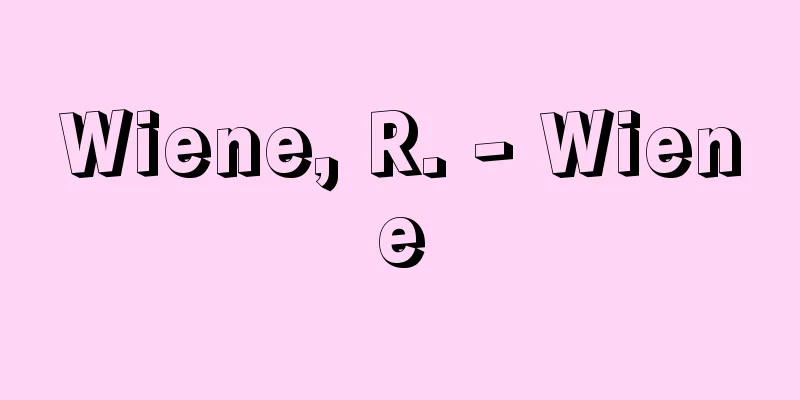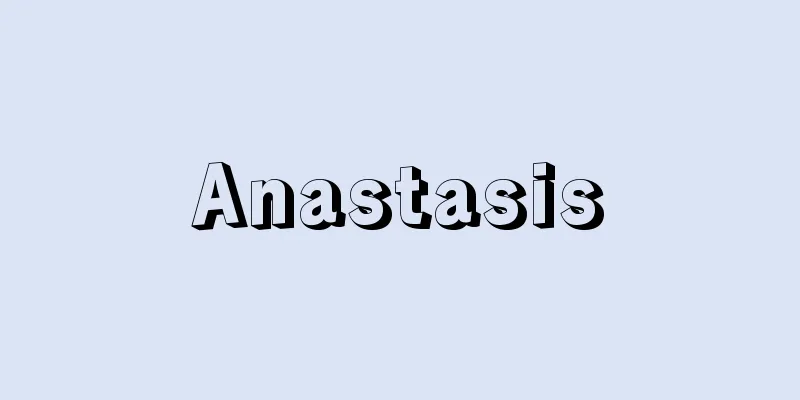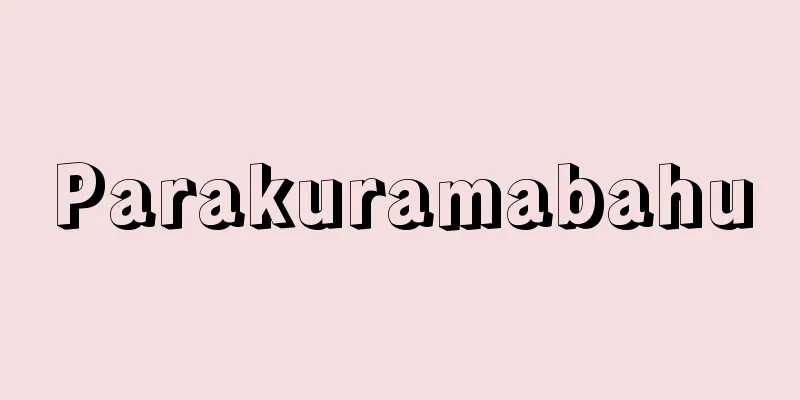Gobi Desert - Gobi Sabaku (English spelling) Gobi

|
The desert steppe (short grass grassland) and desert that spreads from the center to the west of the Mongolian Plateau, straddling China and Mongolia. Gobi is a Mongolian word that originally means a place with few forests and running water, short and sparse grass, sandy and pebbly soil, and no Tarbagan (a mammal of the squirrel family). Currently, such places east of central Central Asia are called Gobi even if they are not the Gobi Desert. In China, it is written as Gobi. The Gobi Desert as a proper name borders the pure steppe area of the Eastern Great Plain in eastern Mongolia in the east, the pure steppe area that stretches east-west south of the Khangai and Hentei mountain ranges in the north, the Taklimakan Desert in the west, and the mountain forest steppe of the Yinshan and Qilian mountain ranges in the south. It is then subdivided into many Gobis, each with its own unique name. [Junichi Yoshida] Climate and TopographyThe altitude is 900-1200 meters, high in the west and low in the east, and it is the lowest area on the Mongolian Plateau. The climate is continental, with a large daily and annual temperature range. The annual range reaches 85°C (maximum 45°C in July, minimum -40°C in January). On the Mongolian side, the average temperature in July is around 20°C, and in January it is -18°C, with a maximum of 41°C and a minimum of -48°C. The wind speed in the area averages 3.5 meters and a maximum of 34 meters. The annual precipitation in the Gobi Desert is 200-250 mm (average 148 mm on the Mongolian side). Most of the areas with an annual precipitation of 100 mm or more are desert steppes, and most of the areas with an annual precipitation of less than 100 mm are deserts. The central to west Gobi is divided in two by the Altai Mountains, but much of the eastern Gobi and the area north of these mountains, which stretches all the way to the area around Lake Uvs, are desert steppe, while most of the area south of the Altai Mountains is desert. The latter is located more inland than the former, and is much drier. The Gobi Desert is characterized by being widely covered with gravel. Sand dunes also exist, but these are more prevalent in the desert steppe. There are also many dried-up soda ponds and areas that contain soda. The Gobi Desert accounts for 41.6% of Mongolia, of which 27.1% is desert steppe and 14.5% is desert. [Junichi Yoshida] Animal habitats and livestock farmingThe Gobi Desert is home to some animals that were once widespread throughout the steppe but are now rare. These include the wild ass (Kran), wild camel (Haptogai), the gazelle (Har-Sult-Zeir), and the saiga (Bohon). The wild horse (Takhi, Przewalski's horse) has not been seen in recent years. Other animals include a significant number of antelopes (Zeir, Yellow Sheep), wild goats (Yangir), and wild sheep (Algar), as well as the unusual Gobi brown bear (Mazarai) and snow leopard (Ilbes). The grass in the Gobi Desert is short and sparse, but it is the most nutritious of the grasses in other steppes, namely forest steppe and pure steppe. The Gobi Desert also contains a lot of soda, which is essential for livestock feed. The Gobi can therefore be a good pastureland as long as there is water, which is often obtained from springs or wells. Thus, there are far fewer sheep in the Gobi Desert than in other steppes, and far fewer cattle, which are susceptible to dryness, but there are by no means few horses, and goats and camels are by far the most numerous. In the case of Mongolia, 50% of the country's goats and 70-75% of its camels are raised in the Gobi Desert. Although the desert is inferior as pasture land to the desert steppes, it is suitable for raising camels. In this sense, the Gobi Desert is not as barren as is commonly thought, and compared to other steppes, it is evaluated as a land where a distinctive type of nomadic lifestyle is practiced. [Junichi Yoshida] A desert that spreads from the central part of the Mongolian Plateau to the west. It is one of the representative high-latitude deserts. Near Dalanzadgad, Mongolia © Yoshihiko Akagi "> Gobi Desert Source: Shogakukan Encyclopedia Nipponica About Encyclopedia Nipponica Information | Legend |
|
中国とモンゴルにまたがり、モンゴル高原の中央部以西に広がる砂漠性ステップ(短草草原)と砂漠。ゴビとは、モンゴル語で、本来、森林・流水が乏しく、草が短くまばらであり、砂と小石が多い土壌をもち、タルバガン(リス科の哺乳(ほにゅう)類)の生息していない所を意味する普通名詞である。現在、中央アジア中部以東のこのような所は、ゴビ砂漠でない場所でもゴビと称している。中国では戈壁(ゴビ)と表記する。固有名詞としてのゴビ砂漠は、東はモンゴル東部の東部大平原の純ステップ地帯に接し、北はハンガイ、ヘンテイ両山脈の南方を東西に延びる純ステップ地帯に接し、西はタクリマカン砂漠に接し、南は陰山(いんざん/インシャン)、祁連(きれん/チーリエン)両山脈の山岳森林ステップに接する。そしてその内部が固有の名称をもつ多くのゴビに細分される。 [吉田順一] 気候・地形標高は900~1200メートルで西高東低であり、モンゴル高原においてもっとも低い地帯である。大陸性気候が支配し、気温の日較差、年較差が著しい。年較差は85℃(最高気温は7月の45℃、最低気温は1月の零下40℃)に達する。モンゴル側は、7月の平均気温は20℃前後、1月のそれは零下18℃、最高気温は41℃、最低気温は零下48℃である。また同地域の風速は平均3.5メートル、最大34メートルである。ゴビ砂漠の年降水量は200~250ミリメートル以下(モンゴル側は平均148ミリメートル)である。そして年降水量100ミリメートル以上の地域の多くは砂漠性ステップ、100ミリメートル以下の地域の多くは砂漠となる。ゴビの中部以西はアルタイ山脈によって二分されるが、東部とこの山脈の北側の、ウブス湖周辺にまで広がるゴビの多くは、砂漠性ステップ、アルタイ山脈以南の大半は砂漠である。後者は前者より内陸に位置し、乾燥の度が強い。ゴビ砂漠の特徴は、広く砂利石に覆われていることにある。砂丘も存在するが、それは砂漠性ステップに多い。またソーダの涸(か)れ池、含有地が多い。モンゴルにおいてゴビ砂漠の占める割合は41.6%、このうち砂漠性ステップが27.1%、砂漠が14.5%である。 [吉田順一] 生息動物と牧畜ゴビ砂漠には、かつてステップ全域に広く生息していたが、いまは希少となった動物が残っている。野生ロバ(クラン)、野生ラクダ(ハプトガイ)、コウジョウセンガゼル(ハル・スールト・ゼール)、サイガ(ボホン)などである。野生ウマ(タヒ、プシバルスキーウマ)は近年発見されていない。これら以外の動物としてレイヨウ(ゼール、黄羊)、野生ヤギ(ヤンギル)、野生ヒツジ(アルガル)がかなりおり、変わったものとしてはゴビヒグマ(マザーライ)、ユキヒョウ(イルベス)がいる。ゴビ砂漠の草は、丈が短く生え方はまばらであるが、ほかのステップすなわち森林ステップや純ステップの草に比べて養分はもっとも高い。またゴビ砂漠には家畜の飼料として不可欠であるソーダが多い。そこでゴビは水さえあれば良好な牧草地となりうる。水は多くの場合、泉または井戸から得る。こうしてゴビ砂漠には、ほかのステップに比べるとヒツジがかなり少なく、乾燥に弱いウシはずっと少ないが、ウマはけっして少ないとはいえずヤギとラクダが断然多い。モンゴルの場合についてみると、同国のヤギの50%、ラクダの70~75%がゴビ砂漠で飼育されている。砂漠は砂漠性ステップより牧地として劣るが、ラクダの飼育には適している。こうみると、ゴビ砂漠は普通考えられているほど不毛の地ではなく、ほかのステップに対し、それなりに特色のある遊牧が営まれる土地と評価される。 [吉田順一] モンゴル高原の中央部以西に広がる砂漠。代表的な高緯度砂漠の一つである。モンゴル ダランザドガド付近©赤木祥彦"> ゴビ砂漠 出典 小学館 日本大百科全書(ニッポニカ)日本大百科全書(ニッポニカ)について 情報 | 凡例 |
Recommend
nest-building
…In this way, even if it is not related to reprod...
Engosaku - English
〘Noun〙 A general term for plants in the genus Cory...
Staraya Ryazan' (English spelling)
...Population: 532,000 (1993). The Ryazan Princip...
The Complete Book of Two Dimensions - Niteizensho
A Chinese book of thought. 68 volumes. Edited by X...
Nieuwland, Julius Arthur
Born: February 14, 1878, Hans Beke, Belgium [Died]...
Ideal solution
When components are mixed at constant temperature...
Louis XVIII - Louis
King of France (reigned 1814-1815, 1815-1824). Bro...
Legislative state - Rippo kokka
Modern post-revolution states are based on the pre...
Mr. Koide - Koideuji
A feudal lord in the early modern period. He is sa...
First arm - First arm
… [Tsunetaro Fujita] [Cultural History of Arms] &...
Caciquismo (English spelling)
A political system in Spain and Portugal from the ...
Tatsuo Amano
1892-1974 A nationalist from the Taisho to Showa ...
Aaltonen, W.
… Finnish sculpture and architecture reflect the ...
Ultraviolet photography
A photograph taken using ultraviolet light of a s...
Nicolas Bourbaki
A pseudonym for a group of about a dozen mathemati...









